Выставки[править | править код]
| Год | Выставка | Место | Город | Сноски |
|---|---|---|---|---|
| 1922 | Salon d’Automne | Большой дворец | Париж | |
| 1923 | Exposició de pintures i dibuixos de Joan Miró i Francesc Domingo | Au Cameleon | Париж | |
| 1923 | Conference of A.Schoneber The evolution of the Catalan Poetry | Au Cameleon | Париж | |
| 1925 | Joan Miró | Pierre Gallery | Париж | |
| 1934 | A Century of Progress Exhibition of Painting and Sculpture | Институт искусств | Чикаго | |
| 1935 | Joan Miro, 1933—1934: Painting, gouache, pastels | Pierre Matisse Gallery | Нью-Йорк | |
| 1948 | Picasso, Miró, Gris. Teachers of Spanish painting of the twentieth century | Музей современного искусства Сан-Франциско and Художественный музей Портленда | Сан-Франциско и Портленд | |
| 1959 | Joan Miró | MoMA and Загородный художественный музей Лос-Анджелеса | Нью-Йорк и Лос-Анджелес | |
| 1960 | Permanent collection | MoMA | Нью-Йорк | |
| 1964 | Joan Miró | Галерея Тейт и Кунстхаус (Цюрих) | Лондон и Цюрих | |
| 1978 | Aspects of Twentieth-Century Art | Национальная галерея искусства | Вашингтон | |
| 1980 | Miró: Selected paintings | Музей Хиршхорна Сад скульптур в Вашингтоне и Художественная галерея Олбрайт-Кнокс | Вашингтон и Буффало | |
| 1986-1987 | Joan Miró: A Retrospective | Кунстхаус (Цюрих); Кунстхолл Дюссельдорфа и Музей Соломона Гуггенхайма | Дюссельдорф, Цюрих и Нью-Йорк | |
| 1987-1988 | Five Centuries of Spanish Art: The Century of Picasso | Музей современного искусства (Париж) иЦентр искусств королевы Софии, | Париж и Мадрид | |
| 1990 | Joan Miró: Estudi retrospectiu de l’obra de pintura | Фонд Майхт | Сен-Поль-де-Ванс | |
| 1993 | Joan Miró: 1893—1993 | Фонд Жоана Миро и MoMA | Барселона и Нью-Йорк | |
| 1998-1999 | Joan Miró | Музей современного искусства & Луизиана | Стокгольм & Хумблебёк | |
| 2001 | Paris-Barcelona | Большой дворец i Музей Пикассо (Барселона) | Париж и Барселона | |
| 2002 | Joan Miró. Snail, woman, flower, Star | Stiftung Museum Kunst Palast | Дюссельдорф | |
| 2004 | Joan Miró 1917—1934: La Naissance du Monde | Центр Помпиду | Париж | |
| 2006-2007 | Barcelona and Modernity: Gaudí to Dalí | Кливлендский художественный музей и Метрополитен-музей | Кливленд и Нью-Йорк | |
| 2011 | Joan Miró. L’escala de l’evasió | Галерея Тейт и Фонд Жоана Миро | Лондон и Барселона |
Miró’s Wall of the Barcelona Airport, 1970
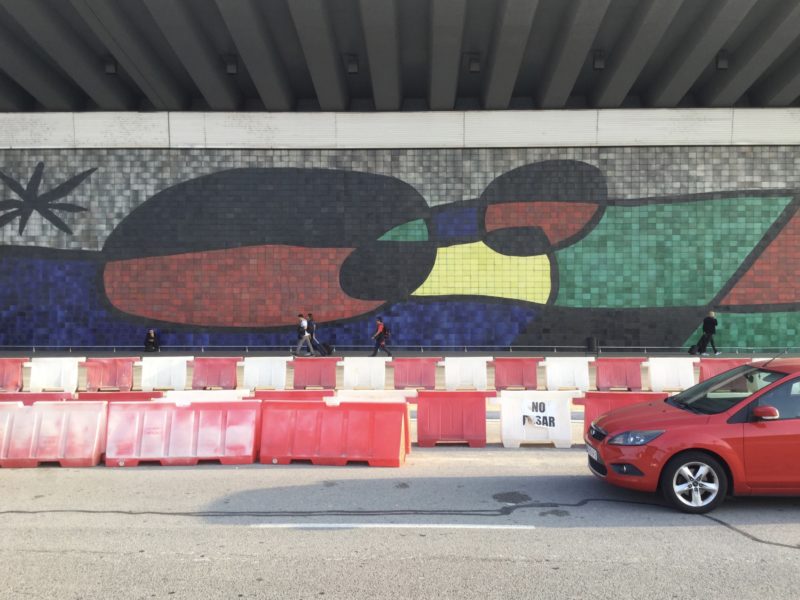 Joan Miró – Wall of the Barcelona Airport, 1970, earthenware, 10 x 50 m, Terminal B, El Prat Airport, Barcelona, Spain, photo: Zinneke, CC BY-SA 3.0
Joan Miró – Wall of the Barcelona Airport, 1970, earthenware, 10 x 50 m, Terminal B, El Prat Airport, Barcelona, Spain, photo: Zinneke, CC BY-SA 3.0
Barcelona is one of Europe’s art centers, and for those visiting via air travel, you don’t have to venture any further into the city to find the first artistic proof. You only have to step off the plane to find the first exhibit – the mural at Barcelona Airport by Miró and Josep Llorens at the airport’s Terminal 2. The mural was executed by Llorens in 1970 and consists of more than 4,800 glazed ceramic slabs, standing 10 meters high and stretching 50 meters.
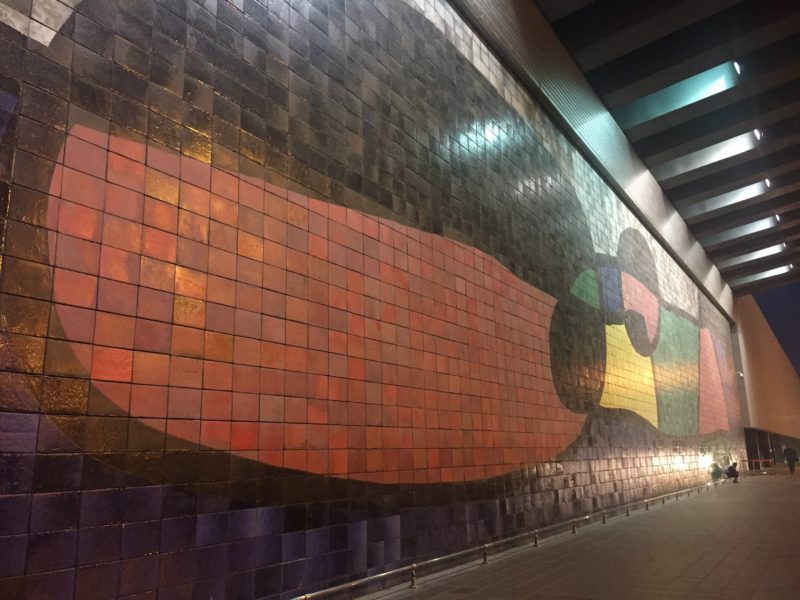 Joan Miró – Wall of the Barcelona Airport, 1970, earthenware, 10 x 50 m, Terminal B, El Prat Airport, Barcelona, Spain, photo: public domain
Joan Miró – Wall of the Barcelona Airport, 1970, earthenware, 10 x 50 m, Terminal B, El Prat Airport, Barcelona, Spain, photo: public domain
The story of this airport mural is similar to the other two Miró sculptures in the city of Barcelona, Woman and Bird and Mosaic del Pla de I’Os. The Barcelona City Council approached Miró to create one of his famous ceramic murals to welcome visitors to the city who arrived at the airport. Miró loved this idea so much that he suggested two more murals in addition to the first so that they can welcome visitors to the city who arrived by air, land, and sea. Therefore, the Pla de I’Os Mosaic is supposed to welcome visitors who came to the city by sea while the 60 meters tall Woman and Bird offers the same gesture but for those entering Barcelona through the land.
 Joan Miró – Wall of the Barcelona Airport, 1970, earthenware, 10 x 50 m, Terminal B, El Prat Airport, Barcelona, Spain, photo: CC BY-NC-ND 2.0 by mydograzzle
Joan Miró – Wall of the Barcelona Airport, 1970, earthenware, 10 x 50 m, Terminal B, El Prat Airport, Barcelona, Spain, photo: CC BY-NC-ND 2.0 by mydograzzle
Once again, Miró worked with Llorens for this mural, and they stayed true to their meticulous and reflective style. The final painting consists of Miró’s signature, brightly colored ceramic pieces. Joan would spend a lot of his time creating the robust mosaic. However, unexpected details and tones emerged during the firing of the murals in the kiln, which enthralled the artists.
Such details take a lot of time to preserve, making facelifts of the various art pieces rather time-consuming. For instance, the airport mural took a record 9 years to restore, but the outcome is worth every second spent.
Fundació Pilar i Joan Miró a Mallorca, Spain
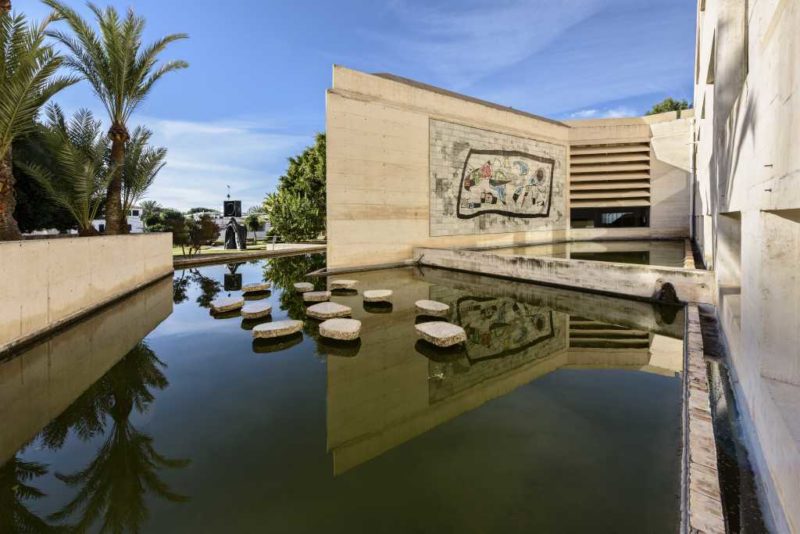 Joan Miró (in collaboration with Maria Antònia Carrió Payeras) – Untitled, 1992, ceramics, 464 x 970 cm, installation view, Fundació Pilar i Joan Miró a Mallorca, Spain, photo: Rubén Perdomo
Joan Miró (in collaboration with Maria Antònia Carrió Payeras) – Untitled, 1992, ceramics, 464 x 970 cm, installation view, Fundació Pilar i Joan Miró a Mallorca, Spain, photo: Rubén Perdomo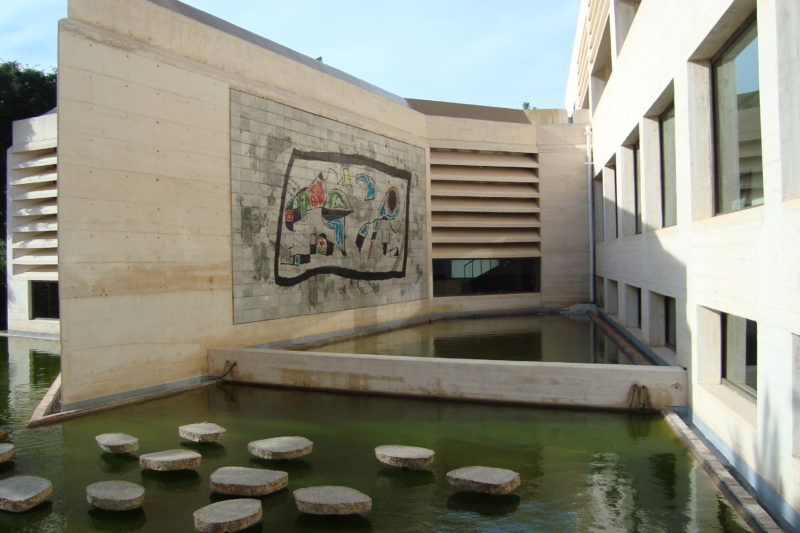 Joan Miró (in collaboration with Maria Antònia Carrió Payeras) – Untitled, 1992, ceramics, 464 x 970 cm, installation view, Fundació Pilar i Joan Miró a Mallorca, Spain, photo: CC BY-NC 2.0 by masia vilalta
Joan Miró (in collaboration with Maria Antònia Carrió Payeras) – Untitled, 1992, ceramics, 464 x 970 cm, installation view, Fundació Pilar i Joan Miró a Mallorca, Spain, photo: CC BY-NC 2.0 by masia vilalta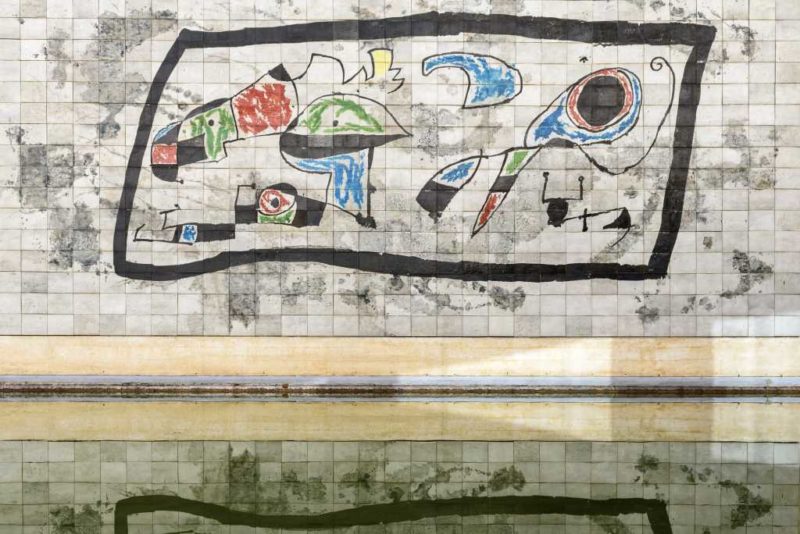 Joan Miró (in collaboration with Maria Antònia Carrió Payeras) – Untitled, 1992, ceramics, 464 x 970 cm, installation view, photo: Pep Escoda
Joan Miró (in collaboration with Maria Antònia Carrió Payeras) – Untitled, 1992, ceramics, 464 x 970 cm, installation view, photo: Pep Escoda
Although he was born and bred in Barcelona and grew up as an artist in the French capital, Mallorca (Majorca) and Miró were bonded for eternity after falling in love with the island and its people. His mother, as well as his wife, Pilar Juncosa, were also Majorcans. They would live on the island from 1956 until he died in 1983.
Miró and Pilar created the Miró Mallorca Foundation in 1981. Later, the museum building was designed by Rafael Moneo and constructed in 1992. The museum houses more than 6000 works donated by Miró, including numerous paintings and sculptures and a sculpture garden.
Miró’s presence in the region goes further. When you walk through Palma, you will come across three works by him – two sculptures, one at the foot of the Royal Palace of the Almudaina and a mosaic (Parc del Mar).
Описание
На полотне преобладают охры земли и голубизна неба. Объекты детализированы наивно и без формальной перспективы. Отметим слева направо:
Ферма (левая часть)
Главный корпус фермы. Он светло-коричневого цвета. Показаны окна, дверь, подъемные виселицы и трещины в стенах. Через открытую дверь мы видим заднюю часть лошади. На переднем плане перед зданием сверху вниз изображены следующие элементы: борозды, топор, ведро, на переднем плане томатный рубанок.
Справа от этого здания навес, под которым хранится тележка. Снизу на передний план тележка, стремянка, ведро для урожая, собака (такса), высокий горшок.
Дерево (центральная часть)
В центре дерево, возможно вяз . За ним таз и постирочная, где работает женщина. Перед деревом ведро, лейка. Под лейкой помещается сложенная газета, на которой можно прочитать » Внутреннюю» и пять колонок для чтения. Чуть левее лейки брусчатка из 9 плиток, от которой тропинка ведет к прачечной. Путь отмечен 7 следами . Мы замечаем на краю тропинки растение, возможно агаву .
Позади мойки стоит набор, который может быть прессом для вина.
Сарай (правая часть)
Амбар сзади виден в разрезе. Видим набор хранения и инструментов. Под карнизом мы видим петуха и птицу поменьше. У стены сарая поднимается сетка, в которой появляются мелкие животные и инструменты. Среди прочего мы находим: складную лестницу, на которой отдыхают две птицы, осла, которого также увенчивает птица, еще одного петуха, ящик, голову кролика.
Перед забором участок пустыря с улиткой, галькой и сорняками, голубой русло потока воды. В небе нарисован диск. Он может представлять солнце как луну.
Справа от холста мы можем видеть на заднем плане каменный навес, который расширяет сарай, и лестницу, дающую доступ к невидимым областям. Перед этим солидным зданием находятся развалины деревянного помещения.
История
Дом Жоана Миро
Хотя художник родился в Барселоне, он всегда был связан с сельским миром, особенно с городом Монт-Роч-дель-Камп. На его ранних работах уже видно влияние пейзажей.
Картина была продана Хэмингуэю за пять тысяч французских франков. Хемингуэй писал в 1934 году в журнале Cahiers d’Art: «Я не поменяю „Ферму“ на на одну другую картину мира».
Позже Миро использовал виды Мон-Роч-дель-Камп в других своих картинах.
Миро говорил, что создание картины заняло 9 месяцев напряжённой работы, по 7—8 часов каждый день, и отмечал, что 9 месяцев также и срок человеческой беременности. Он также писал, что хотел показать как горы, так и муравьёв, жаловался, что в Париже тяжело было передавать дух Каталонии. При этом один из торговцев произведениями искусства всерьёз предлагал разделить холст на 8 частей, чтобы его было легче продать.
Дом, принадлежащей семье Миро, Мас Миро, в 2006 году был объявлен культурным достоянием по национальным интересам. После долгих лет переписки между семьей и различными общественными учреждениями было достигнуто соглашение по созданию в нём «живого музея».
Выставки
| Год | Выставка | Место | Город | Сноски |
|---|---|---|---|---|
| 1922 | Salon d’Automne | Большой дворец | Париж | |
| 1923 | Exposició de pintures i dibuixos de Joan Miró i Francesc Domingo | Au Cameleon | Париж | |
| 1923 | Conference of A.Schoneber The evolution of the Catalan Poetry | Au Cameleon | Париж | |
| 1925 | Joan Miró | Pierre Gallery | Париж | |
| 1934 | A Century of Progress Exhibition of Painting and Sculpture | Институт искусств | Чикаго | |
| 1935 | Joan Miro, 1933—1934: Painting, gouache, pastels | Pierre Matisse Gallery | Нью-Йорк | |
| 1948 | Picasso, Miró, Gris. Teachers of Spanish painting of the twentieth century | Музей современного искусства Сан-Франциско and Художественный музей Портленда | Сан-Франциско и Портленд | |
| 1959 | Joan Miró | MoMA and Загородный художественный музей Лос-Анджелеса | Нью-Йорк и Лос-Анджелес | |
| 1960 | Permanent collection | MoMA | Нью-Йорк | |
| 1964 | Joan Miró | Галерея Тейт и Кунстхаус (Цюрих) | Лондон и Цюрих | |
| 1978 | Aspects of Twentieth-Century Art | Национальная галерея искусства | Вашингтон | |
| 1980 | Miró: Selected paintings | Музей Хиршхорна Сад скульптур в Вашингтоне и Художественная галерея Олбрайт-Кнокс | Вашингтон и Буффало | |
| 1986-1987 | Joan Miró: A Retrospective | Кунстхаус (Цюрих); Кунстхолл Дюссельдорфа и Музей Соломона Гуггенхайма | Дюссельдорф, Цюрих и Нью-Йорк | |
| 1987-1988 | Five Centuries of Spanish Art: The Century of Picasso | Музей современного искусства (Париж) иЦентр искусств королевы Софии, | Париж и Мадрид | |
| 1990 | Joan Miró: Estudi retrospectiu de l’obra de pintura | Фонд Майхт | Сен-Поль-де-Ванс | |
| 1993 | Joan Miró: 1893—1993 | Фонд Жоана Миро и MoMA | Барселона и Нью-Йорк | |
| 1998-1999 | Joan Miró | Музей современного искусства & Луизиана | Стокгольм & Хумблебёк | |
| 2001 | Paris-Barcelona | Большой дворец i Музей Пикассо (Барселона) | Париж и Барселона | |
| 2002 | Joan Miró. Snail, woman, flower, Star | Stiftung Museum Kunst Palast | Дюссельдорф | |
| 2004 | Joan Miró 1917—1934: La Naissance du Monde | Центр Помпиду | Париж | |
| 2006-2007 | Barcelona and Modernity: Gaudí to Dalí | Кливлендский художественный музей и Метрополитен-музей | Кливленд и Нью-Йорк | |
| 2011 | Joan Miró. L’escala de l’evasió | Галерея Тейт и Фонд Жоана Миро | Лондон и Барселона |
Hemingway was among his fans
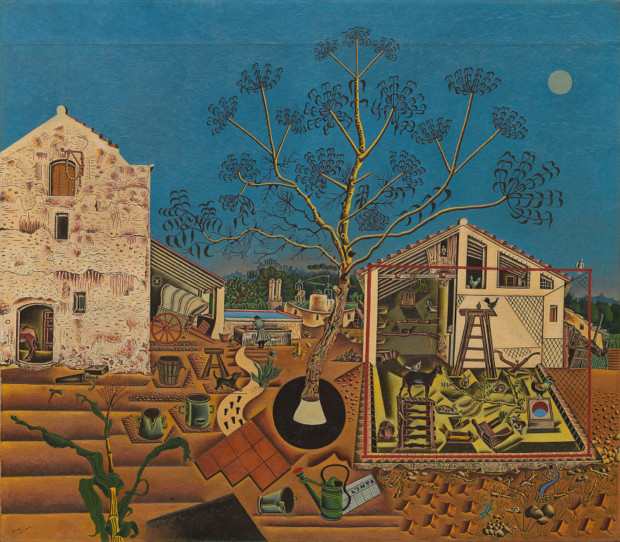 Joan Miró, The Farm, 1921-1922, National Gallery of Art, Washington, DC, USA.
Joan Miró, The Farm, 1921-1922, National Gallery of Art, Washington, DC, USA.
The Farm was bought by Hemingway (who was also an art collector) but not without difficulty. Miró didn’t want to sell it, it was too important to him. However, the writer agreed with Miró’s dealer to pay 5,000 francs for it, which, he recalled, “was four thousand two hundred and fifty francs more than I had ever paid for a picture…” When it was time to make the last payment he risked losing the painting because he didn’t have the money. On the final day he trawled around every bar he knew in Paris, with his friend John Dos Passos, borrowing cash and eventually raising the funds.
История
Главный вид Мас Миро, семейный дом Жоана Миро.
Художник хоть и родился в Барселона, всегда был связан с сельским миром, особенно с городом Мон-Роч-дель-Камп, и его ранние работы показывают влияние пейзажей и характеров их летних деревенских пейзажей на земле Таррагона. Эти отношения с землей можно запечатлеть на картинах, написанных между 1918 и 1924 годами. Огород с ослом(1918) или Монтройг, церковь и люди(1919). Ферма был начат во время первой поездки Миро обратно в Мон-Роч-дель-Камп из Франции и был завершен в Париж. Это было время, когда Миро обосновался в Париже и чередовался с некоторыми путешествиями, особенно летом в Мон-Роч.
Наблюдение за всем вокруг и огнями на камнях и деревьях, которые в определенное время меняли яркость солнца, заставило художника почувствовать себя привязанным к стихии земли, о которой было сказано:
По экономической необходимости он начал тур с арт-дилеры продать это произведение искусства. Леонсе Розенберг, среди других, которые заботились о картинах Пикассо, согласился хранить полотно и в любое время по настоянию Миро всерьез предложил разделить полотно на мелкие кусочки, чтобы его было легче продать. Миро, рассерженный, взял холст и отнес в мастерскую. Затем Жак Вио из галереи Пьера, который после нескольких обработок продал ее писателю. Эрнест Хемингуэй, за пять тысяч французские франки. Хемингуэй написал в 1934 году в журнале Cahiers d’art, «Я не изменю Ферма для любой картины мира »
Позже Миро использовал район Мон-Роч в других работах, таких как Земля и рабочий или же Каталонский пейзаж (Охотник). В них, как в Ферма, можно наблюдать преемственность в трансформации образных форм в другие места, где есть все виды символ и графика.
История Миро
Миро был первым репортером, рассказавшим о своих работах:
Здание дома, принадлежащего семье Миро, Мас Миро был объявлен Культурный объект национального интереса в 2006 году. После нескольких лет бумажной работы между семьей и различными государственными учреждениями они заключили соглашение о превращении проекта в действующий музей, где будут выставлены личные вещи художника в дополнение к воссозданию их самых важных работ, в том числе Ферма через принты, которые показывают качество и текстуру картин маслом. Согласно заявлениям, сделанным внуком художника Эмилио Фернандес Миро, «помимо Барселоны Фонд Жоана Миро и семья поставляет оригинальные произведения. В доме полно граффит, которые мой дед использовал в качестве эскизов для своих работ Мы хотим, чтобы это был живой музей. Мы будем выполнять работы по очереди ».
Примечания[править | править код]
- ↑
- DDAA. the Great Encyclopedia in Catalan: volume 13 (англ.). — Barcelona: editions 62, 2004. — ISBN 84-297-5441-5.
- : P. 4
- : pp. 29-32
- Paporov, Yuri. Hemingway in Cuba (исп.). — Editorial Siglo XXI, 1993. — С. 92. — ISBN 9789682318481.
- Declarations: p.158 and next. included in Joan Miro: hidden intentionality of his life and work by Saturnino Fishing Ed. Erasmus, 2009, ISBN 9788493697211 pp. 100—101
- . Patrimoni.gencat. Дата обращения: 6 октября 2011.
- Joseph, Massot (исп.). La Vanguardia. Дата обращения: 6 октября 2011.
- Catalogue no. 1754
- май 1923
- 9 апреля 1923
- Catalogue piece no. 1.
- Catalogue pieceno. 355.
- Reference Catalogue no. 1.
- The exhibition took place between 10 January and 9 February 1935, and showed 30 works in total.
- unnumbered catalog. Only shown in New York
- Планируется в постоянной коллекции Нью-Йоркского музея современного искусства, 1960—1962
- no. 28, displayed
- . Дата обращения: 20 августа 2011. Catalog Number no. 77, which is reproduced.
- no. 9, displayed. (only shown at Washington)
- ↑ no. 20 (available in German), no. 14 (available in English) is reproduced.
- 1987-1988, no. 22 (French catalog), no. 20 (available in Spanish), which is reproduced.
- no. 12, displayed
- not. 47 (available in Spanish), no. 22 (available in English) is reproduced.
- no. 6, displayed
- . Музей Пикассо. Дата обращения: 20 августа 2011.
- unnumbered catalog, which is reproduced. (Catalogue in French), no catalog number, Fig. 4 (available in Spanish)
- no. 5, displayed.
- The work is reproduced, displayed with the catalog number 19
- . Centre Pompidou. Дата обращения: 20 августа 2011.
- . Дата обращения: 20 августа 2011.
- In the same exhibition were works such as Bal du Moulin de la Galette, Ramon Casas i Pere Romeu en un tàndem by Ramon Casas and Desconsol by Josep Llimona, among others.
- . Дата обращения: 12 октября 2011.
Formal Analysis: A Brief Compositional Overview
The Horse, Pipe, and Red Flower by Joan Miró undoubtedly depict influences from the Cubist and Surrealist art style, to which he had exposure. The formal analysis below will visually describe Joan Miró’s collage painting. It will then analyze the painting according to the elements and principles of art, namely the colors, texture, lines, shapes, forms, and how space is portrayed and utilized.

People inside an exhibition hall, watching works by Joan Miro, In Frieder Burda Museum, Baden-Baden, Germany (2010); Vintagenie, CC BY-SA 4.0, via Wikimedia Commons
Subject Matter: Visual Description
In the Horse, Pipe, and Red Flower painting Joan Miró depicts his subject matter as a still-life in a collage-styled composition. It is a colorful rendition of an assortment of seemingly random objects and items on what appears to be a table. The setting appears to be a room of sorts, with most of the items on the table. The room has a floor, which appears blue, and a wall (or what appears to be a wall) that is cream in color with zig-zagged and geometric patterns.
To the right of the book is a long white pipe lying at an angle, next to the pipe is a wine glass with a red flower inside it. Behind the wine glass is a mishmash of colorful patterns. It is unclear what these could be if they are anything at all. Placed towards the back of the table is a small white horse, which has been described as a figurine. In the far background is what appears to be an image on the wall depicting a landscape setting. This has been surmised as either being a painting or a window to the outside environment.
Color
Joan Miró utilized a myriad of colors in his Horse, Pipe, and Red Flower painting. There is a combination of primary colors like reds, blues, and yellows, which are also in a variety of tones, for example, the red flower in the wine glass is a deep red. Secondary colors are also evident like green and orange. These are also placed alongside the primary colors, for example in the lower right portion of the composition, notice the red and green of the table overlapped with the brilliant blue of the flooring. The variety of colors creates movement and dynamism in the Horse, Pipe, and Red Flower painting.
Line
As one of the art elements, lines provide the structure of objects or forms, the outline so to say. There are also different types of lines in which Joan Miró’s Horse, Pipe, and Red Flower painting is filled with. There are curved, zigzagged, wavy, and straight lines all occurring in different lengths, from short to long, and orientations, from vertical, horizontal, and diagonal.
Texture
There are a variety of textures in the Horse, Pipe, and Red Flower painting by Joan Miró, from the tactile texture of the paintbrush on the canvas, for example, the blue flooring and areas of coloring on the table. There are implied textures of several of the objects, for example, the lines of paint that give the impression of the horse’s hair or the lighter whites on the wine glass that suggest its shiny surface.
Space
Most of the compositional space to the left side is chock-full, which is contrasted by the emptier space to the left and below the table. Additionally, the whole table is not in view, but only what is on the left side of it. The table is colorful compared to the wall and floor, which creates a subtle sense of depth, however, there appear to be multiple angles simultaneously depicted on the table.
Shape and Form
There are multitudes of shapes and forms in Joan Miró’s Horse, Pipe, and Red Flower painting, from geometric angles of the patterns on the table to the organic (naturalistic) forms of the flower, the horse, and the landscape depicted on the painting or window in the background. Some of the other shapes and forms include the two large oval shapes in the background, the square-like shapes of the patterns on the wall to the right, the triangular shapes created by the patterns along the rim and edge of the table in the foreground, and the spherical form of the wine glass.
Composition of the Painting
The painting features a composition of various elements, including a farmhouse, trees, animals, and objects, all rendered with simplified and abstract forms. Miro’s use of vibrant colors and bold, organic shapes contributes to the painting’s
The painting is highly acclaimed for it has the fluency of the poem and picture. The work illustrates important innovations signature to the artist as it includes various abstracted elements such as the black circle where the eucalyptus tree rises in the centers, symbols such as two ladders, one with the goat standing at the top while the other with the rooster on the top.
This artwork was deemed as most important even by the artist himself for it marked a turning point in his artistic career. It reflects a wide variety of influences, including Catalan folk art, a Romanesque sense of hierarchy where scale reflects the importance, and a cubist vocabulary, the work heavily exemplifying the artist’s restless and iconoclastic approach.
Symbolically, “The Farm” represents more than a literal depiction of a farm. It embodies Miro’s connection to his Catalan roots and his exploration of identity and memory. The farm was a representation of his family heritage and the rural environment in which he grew up. It reflects his deep attachment to his homeland and serves as a visual tribute to his roots.
The simplified forms and flattened perspective demonstrate his departure from traditional representational art and his embrace of a more subjective and imaginative approach.

He created a tapestry for World Trade Center in New York
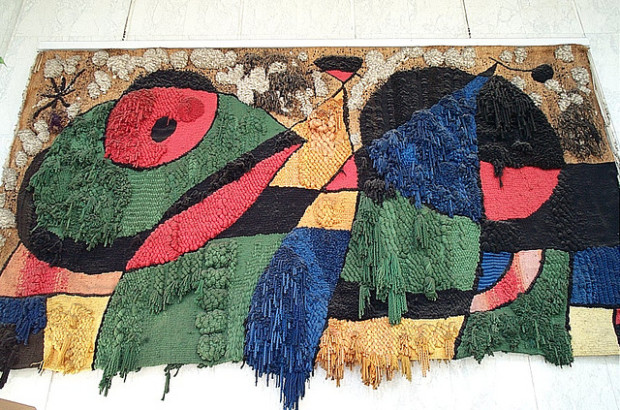 Joan Miró, The World Trade Center Tapestry, destroyed. .
Joan Miró, The World Trade Center Tapestry, destroyed. .
Another surprising Joan Miró fact is that in 1974 he created a tapestry for the World Trade Center in New York City, together with the Catalan artist Josep Royo. He initially refused to do the tapestry, then he learned the craft from Royo and the two artists produced several works together. His World Trade Center Tapestry was displayed at the building and was one of the most expensive works of art lost during the 9/11 attacks.
The work was an abstract design, with bright blocks of color in red, green, blue, and yellow, with black elements and a light brown background. Made of wool and hemp, it measured 20 × 35 feet (6.1 × 10.7 m) and weighed 4 tons.
Экспонаты
| Год | Выставка | Место | Город | Ссылка |
|---|---|---|---|---|
| 1922 | Осенний салон | Гранд Пале | Париж | |
| 1923 | Выставка pinture i dibuixos de Joan Miró i Francesc Domingo | Au Cameleon | Париж | |
| 1923 | Конференция А.Шонебера Эволюция каталонской поэзии | Au Cameleon | Париж | |
| 1925 | Жоан Миро | Галерея Пьера | Париж | |
| 1934 | Выставка живописи и скульптуры «Век прогресса» | Художественный институт Чикаго | Чикаго | |
| 1935 | Жоан Миро, 1933-1934: Живопись, гуашь, пастель | Галерея Пьера Матисса | Нью-Йорк | |
| 1948 | Пикассо, Миро, Грис. Учителя испанской живописи ХХ века | Музей искусств Сан-Франциско и Портлендский художественный музей | Сан-Франциско и Портленд, штат Орегон | |
| 1959 | Жоан Миро | МоМА и Музей искусств округа Лос-Анджелес | Нью-Йорк и Лос-Анджелес | |
| 1960 | Постоянная коллекция | МоМА | Нью-Йорк | |
| 1964 | Жоан Миро | Галерея Тейт и Кунстхаус Цюрих | Лондон я Цюрих | |
| 1978 | Аспекты искусства ХХ века | Национальная художественная галерея | Вашингтон, округ Колумбия | |
| 1980 | Миро: Избранные картины | Музей Хиршхорна Сад скульптур в Вашингтоне и Художественная галерея Олбрайт-Нокс | Вашингтон, округ Колумбия и Буффало | |
| 1986–1987 | Жоан Миро: ретроспектива | Кунстхаус Цюрих; Kunsthalle Düsseldorf и Музей Соломона Р. Гуггенхайма | Дюссельдорф, Цюрих и Н.Йорк | |
| 1987–1988 | Пять веков испанского искусства: век Пикассо | Musée d’Art Moderne de la Ville de Paris и Музей королевы Софии, | Париж и Мадрид | |
| 1990 | Жоан Миро: Estudi retrospectiu de l’obra de pintura | Fondation Maeght | Сен-Поль-де-Ванс | |
| 1993 | Жоан Миро: 1893–1993 гг. | Fundació Joan Miró & МоМА | Барселона и Нью-Йорк | |
| 1998–1999 | Жоан Миро | Moderna Museet и Музей современного искусства Луизианы | Стокгольм & Humlebaek | |
| 2001 | Париж-Барселона | Гранд Пале я Музей Пикассо | Париж я Барселона | |
| 2002 | Жоан Миро. Улитка, женщина, цветок, звезда | Stiftung Museum Kunst Palast | Дюссельдорф | |
| 2004 | Жоан Миро 1917–1934: La Naissance du Monde | Центр Жоржа Помпиду | Париж | |
| 2006–2007 | Барселона и современность: от Гауди до Дали | Кливлендский художественный музей и Метрополитен-музей Нью-Йорка | Кливленд и Нью-Йорк | |
| 2011 | Жоан Миро. Лестница побега | Тейт и Fundació Joan Miró | Лондон и Барселона |
The Hunter (Catalan Landscape) – FAQs
Where is The Hunter (Catalan Landscape) located?
Joan Miró’s painting The Hunter (Catalan Landscape) takes place at his home on the family’s farm in Montroig, Catalonia, Spain. This area is an autonomous part of the country. Catalonia has its own character, culture, and politics.
Miró portrayed a symbolic assortment of animals, human elements, and natural forms to represent his unconscious memories from growing up there.
What inspired Joan Miró?
Miró found great inspiration in doodling. He was impetuous and spontaneous when he created artwork and placed high value on his unconscious creations. Miró’s whimsy and natural humor spring from this and draw the viewer into the painting with charming delight and curiosity.
Pla de l’Os, Barcelona
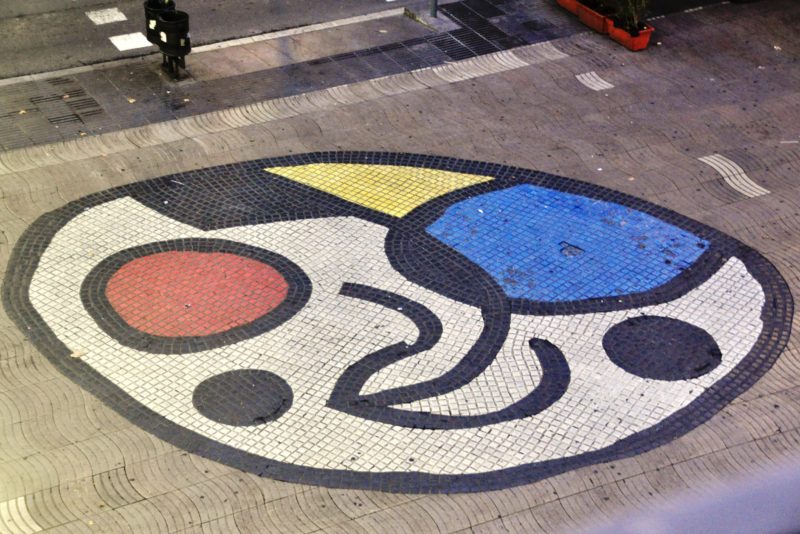 Joan Miró – Mosaic del Pla de l’Os (detail), 1976, mosaic, 7,81 x 8,33 cm, installation view, Pla de l’Os, Barcelona, Spain, photo: eric, 2010-08-24 PM Ramblas – Joan Miro, CC BY 2.0
Joan Miró – Mosaic del Pla de l’Os (detail), 1976, mosaic, 7,81 x 8,33 cm, installation view, Pla de l’Os, Barcelona, Spain, photo: eric, 2010-08-24 PM Ramblas – Joan Miro, CC BY 2.0
This colorful pavement was designed by Miro and executed by Joan Artigas in 1978 and serves as a symbol that ushers in visitors coming into Barcelona through the sea.
The work is called the Pla de I’Os Mosaic or Paviment Miro and is located in Pla de la Boqueria, on Rambla de Barcelona. The mosaic was implemented by Artigas with the support of Escofet workshops, which specializes in terrazzo pieces.
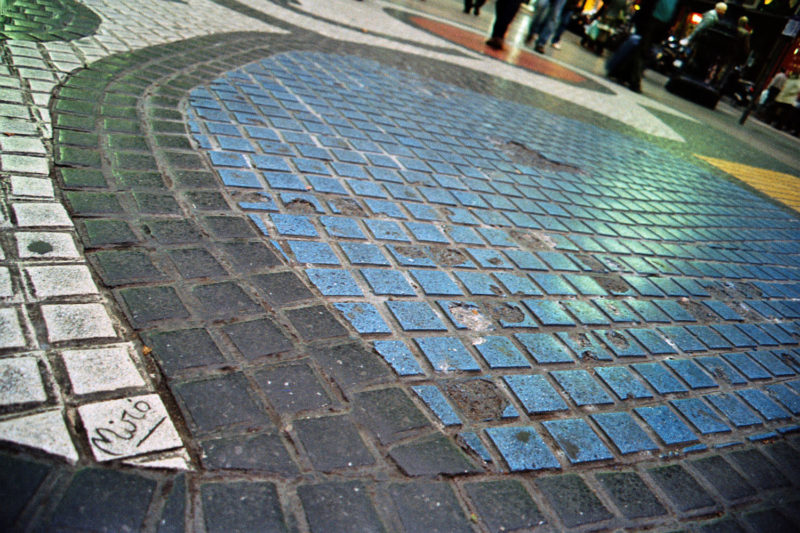 Joan Miró – Mosaic del Pla de l’Os (detail), 1976, mosaic, 7,81 x 8,33 cm, installation view, Pla de l’Os, Barcelona, Spain, photo: Claudio, Mosaico Mirò sulla Rambla, CC BY 2.0
Joan Miró – Mosaic del Pla de l’Os (detail), 1976, mosaic, 7,81 x 8,33 cm, installation view, Pla de l’Os, Barcelona, Spain, photo: Claudio, Mosaico Mirò sulla Rambla, CC BY 2.0
For historians, however, this spot is nothing but a significant historical location. Legend has it that Cunt Berenguer IV brought a gat from Almeria as a war memento. The stunning arabesque structure replaced another equally historical gate of Santa Eulalia and was named Boqueria Gate. But during the demolition of the city gates, the Boqueria Gate vanished, living behind an open space that today is Pla de I’Os.
For Miró, this location also had personal sentiments. He wanted to install one of his works into the pavement near Passage del Credit, his birthplace. Miró wanted passers-by to step on the mosaic as they go about their businesses and wasn’t worried about it getting ruined.
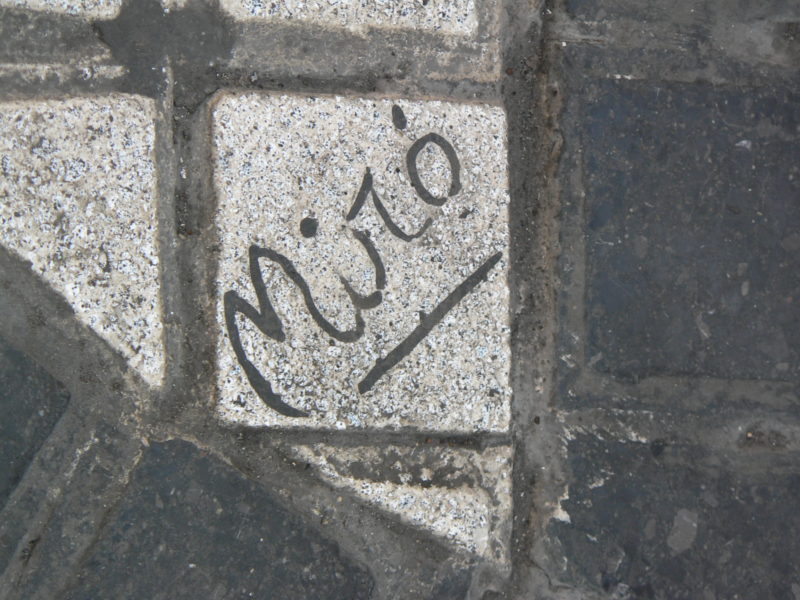 Joan Miró – Mosaic del Pla de l’Os (detail), 1976, mosaic, 7,81 x 8,33 cm, installation view, Pla de l’Os, Barcelona, Spain, photo: Fabio Alessandro Locati, CC BY-SA 3.0
Joan Miró – Mosaic del Pla de l’Os (detail), 1976, mosaic, 7,81 x 8,33 cm, installation view, Pla de l’Os, Barcelona, Spain, photo: Fabio Alessandro Locati, CC BY-SA 3.0
However, after years of thousands of people stepping on it every day, the cobblestones started to deteriorate and the vivid colors faded. In 2006, the city council of Barcelona did restoration work on the mosaic during its 30th anniversary.
In line with the artist’s style, the mosaic comprises circular forms representing the cosmos and depicts entry into the city through the sea. Its primary colors – blue, red, and yellow, as well as its simple forms, are reminiscent of Miró’s language – an innate language that retains the limpidness of the infancy world.



















![The farm [joan miró] | sartle - rogue art history](http://sch176zgr.ru/wp-content/uploads/e/b/5/eb5d5f40202c8af4cab61943afb96a4e.jpeg)








